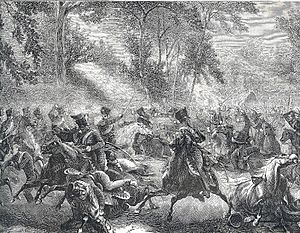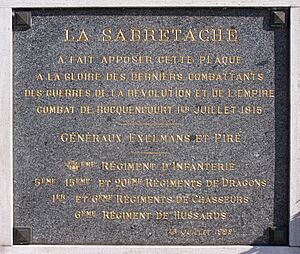Battle of Rocquencourt facts for kids
Quick facts for kids Battle of Rocquencourt |
|||||||
|---|---|---|---|---|---|---|---|
| Part of the Napoleonic Wars (Seventh Coalition 1815) | |||||||
 Combats de Rocquencourt |
|||||||
|
|||||||
| Belligerents | |||||||
| Commanders and leaders | |||||||
| Strength | |||||||
| 3,000 blocking cavalry 1 cavalry division three infantry battalions(from the 33rd Regiment) |
600–700 officers and light cavalry troopers | ||||||
| Casualties and losses | |||||||
| Unknown | 10 officers and 400–500 troopers | ||||||
The Battle of Rocquencourt was a cavalry fight that happened on 1 July 1815. It took place near the villages of Rocquencourt and Le Chesnay in France. French dragoons, led by General Exelmans, defeated a Prussian cavalry group. This Prussian group was a brigade of hussars commanded by Lieutenant Colonel Eston von Sohr. He was badly hurt and captured during the battle.
Lieutenant Colonel Sohr's Prussian cavalry had gone too far ahead of their main army. Their goal was to reach the Orléans road from Paris. They wanted to stop traffic and cause confusion there. However, near Rocquencourt, the Prussians were surprised by a larger French force. They tried to retreat from Versailles but were blocked by the French. They then tried to go towards Saint-Germain-en-Laye. The first group of Prussians was attacked at Rocquencourt. They tried to escape through fields but were trapped in a narrow street in Le Chesnay. Many were killed or captured. Later that day, Prussian troops arrived and took back Rocquencourt.
Contents
What Happened Before the Battle?
After losing the Battle of Waterloo on 18 June 1815, the French army went back to Paris. They got more soldiers there. The armies of Britain and Prussia chased them. By 29 June, these armies were very close to Paris.
Allied Plans to Attack Paris
The leaders of the British and Prussian armies, Duke of Wellington and Prince Blücher, met on 29 June. They decided that one army would face the French defenses near Saint-Denis. The other army would move around and cross the Seine river. This plan was risky, but they thought it was worth it. They knew the French had not built many defenses on the left side of the Seine river.
They also learned that some bridges across the Seine were still usable. Major Colomb found the bridge at Saint-Germain-en-Laye was not destroyed. He quickly took control of it. Another bridge at Maisons was also captured.
Prussian Cavalry's Mission
Prince Blücher quickly used these captured bridges. He ordered Lieutenant Colonel Eston von Sohr to move his cavalry brigade. Sohr's group was to cross the Seine at Saint-Germain the next morning. Then, on 1 July, they were to appear on the Orléans road from Paris. Their mission was to stop traffic and supplies coming from the west and south. Sohr was allowed to make his own decisions.
On 30 June, Sohr's brigade marched through several towns towards Saint-Germain. They met Major Colomb's group there. They continued to Marly, near Versailles, where they camped for the night. On the morning of 1 July, Sohr's group headed for Versailles. They arrived at noon, after some delays. They had sent out smaller groups to gather information about the French army.
French Plans for an Ambush
The French army noticed Lieutenant Colonel Sohr's bold move. General Exelmans, who led the French cavalry south of Paris, decided to attack them. He learned that two Prussian cavalry regiments were coming towards Versailles.
General Exelmans took 3,000 of his own cavalry soldiers. He moved them towards the front of the Prussian group. At the same time, another French cavalry group, led by General Piré, was sent out. Three battalions of infantry (foot soldiers) also joined them. These forces were sent to attack the sides and rear of the Prussian group.
The French planned a very good ambush near Rocquencourt. They placed small groups of soldiers to watch for the Prussians. Their goal was to cut off the Prussian retreat if they were pushed back by Exelmans.
The Battle Begins
The French Trap Closes
It was late in the afternoon when Lieutenant Colonel Sohr heard that French cavalry was coming. His advanced group was already under attack. He immediately moved his two cavalry regiments forward. They pushed the French back into a narrow pass near Vélizy. A fierce fight happened there. The Prussian cavalry became disorganized. As they pulled back, they were attacked by French lancers. These lancers were part of the ambush.
The Prussians then retreated towards Versailles, with the French chasing them. The French tried to enter Versailles, but the Prussians fought bravely at the town gate. This short fight gave the main Prussian group time to gather. They could have escaped through the park towards Saint-Germain. But Sohr expected help from another Prussian army group. So, he chose the more direct road through Rocquencourt.
Prussian Hussars Try to Escape
Around seven in the evening, the Prussian cavalry had gathered their scattered forces. They were about to retreat further towards Saint-Germain. Sohr then received reliable news that French cavalry and infantry had surrounded them. Their escape route was blocked. Sohr made a quick decision. He knew his men were brave. He decided they would fight their way through the French with their swords.
As they left Versailles, the Prussian Hussars were shot at by the French National Guard. Soon, they heard that Prussian and British cavalry were coming from Saint-Germain. But this was a false report. It was actually the 1st Regiment of French Chasseurs (light cavalry). The Prussian Hussars quickly formed up and charged.
The French Chasseurs also charged. But the Prussians completely defeated them. Their commanding officer was shot and fell. As the Hussars chased the Chasseurs, two companies of French infantry opened fire on them. These French soldiers were hidden behind hedges near Le Chesnay. The Hussars reacted to the gunfire. They turned onto a field road to go around the village, which the French occupied.
However, this led them to a bridge and houses also held by French infantry. They faced heavy fire again. With this new obstacle, and knowing that a large French cavalry force was behind them, the remaining Prussians were in trouble. About 150 Hussars rallied around their commander. They dashed across a meadow, trying to force their way through the Village of Le Chesnay.
Fight in the Courtyard at Le Chesnay
In Le Chesnay, the French Chasseurs tried to stop them again, but were defeated once more. The Prussians followed a road through the village. But this road led into a large courtyard with no other way out.
Their path was blocked. French infantry, already in the courtyard, suddenly attacked them. The French cavalry chasing them prevented any escape. Their situation was desperate. But their bravery grew, inspired by Lieutenant Colonel Sohr. He refused to surrender. After Lieutenant Colonel Sohr was badly wounded by a pistol shot, the few remaining Prussians finally gave up.
Before this battle, the Prussian brigade had already lost many men. It had only about 600 to 700 soldiers left. In this battle, they lost ten officers and 400 to 500 more soldiers.
Aftermath
The advanced group of Thielemann's Prussian III Corps arrived later. This group, led by General Borcke, was marching from Saint-Germain. They heard that Lieutenant Colonel Sohr's cavalry had been completely defeated. Borcke quickly moved forward. His advance group soon met French soldiers coming from Versailles. The Prussians immediately attacked and pushed the French back towards Rocquencourt. As it got dark, Borcke carefully set up his forces. He sent forward a battalion of soldiers, supported by another. The rest of his troops were held ready. The Prussian attack was so strong that the French quickly retreated towards Paris. Borcke's troops then camped at Rocquencourt.


